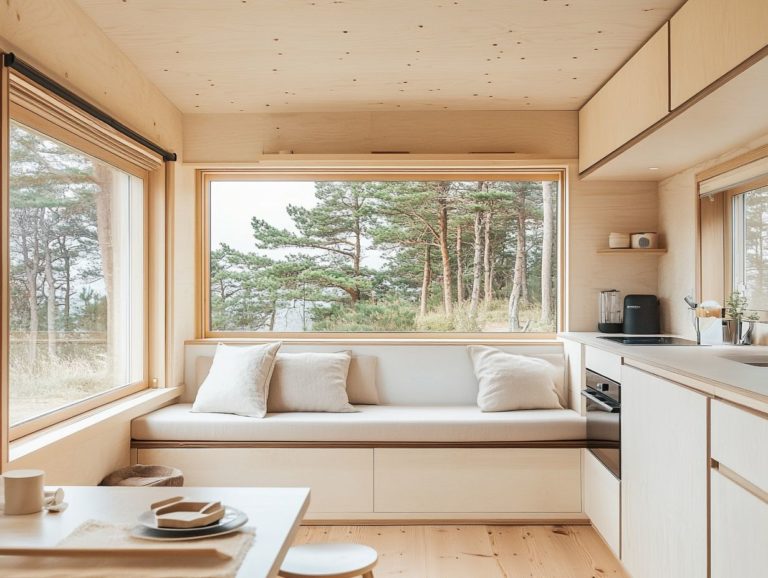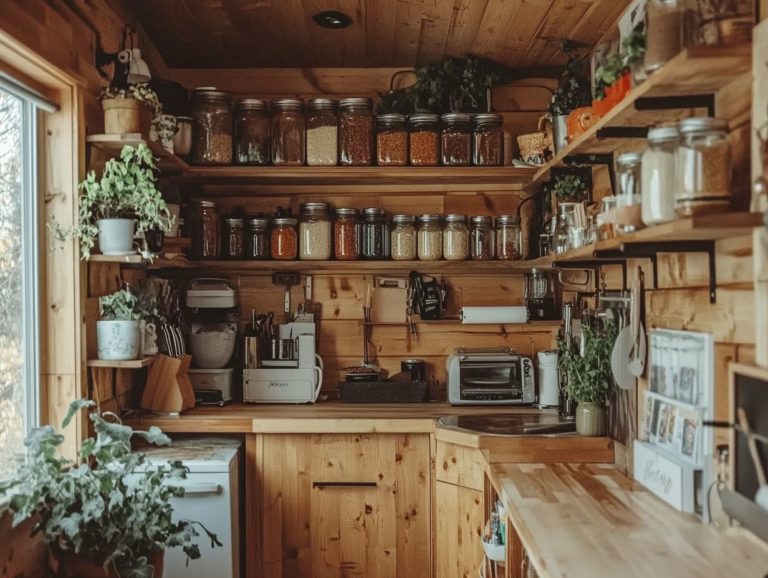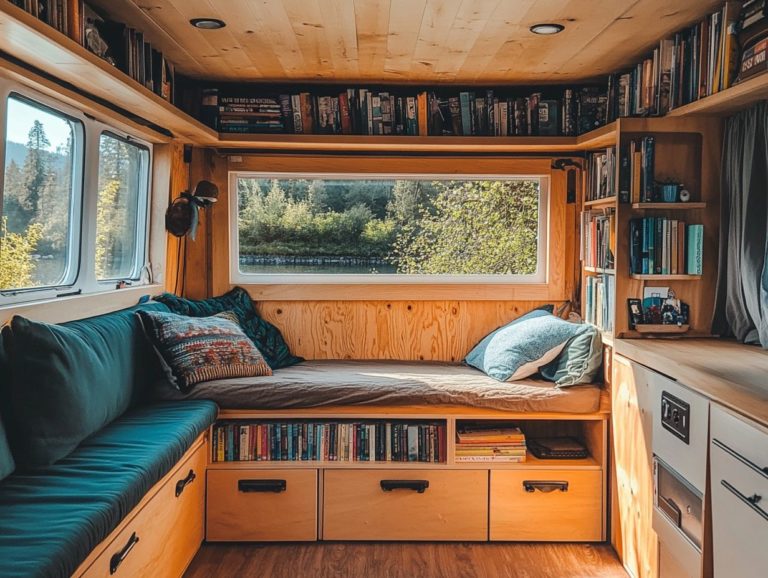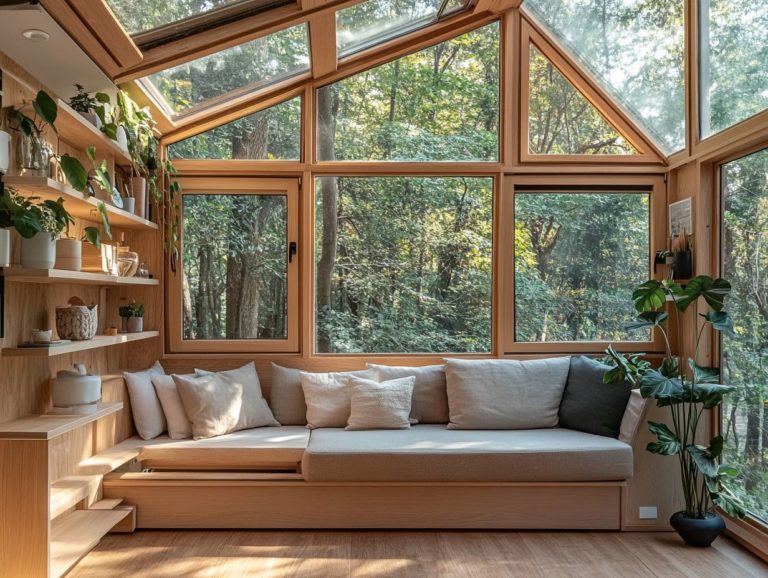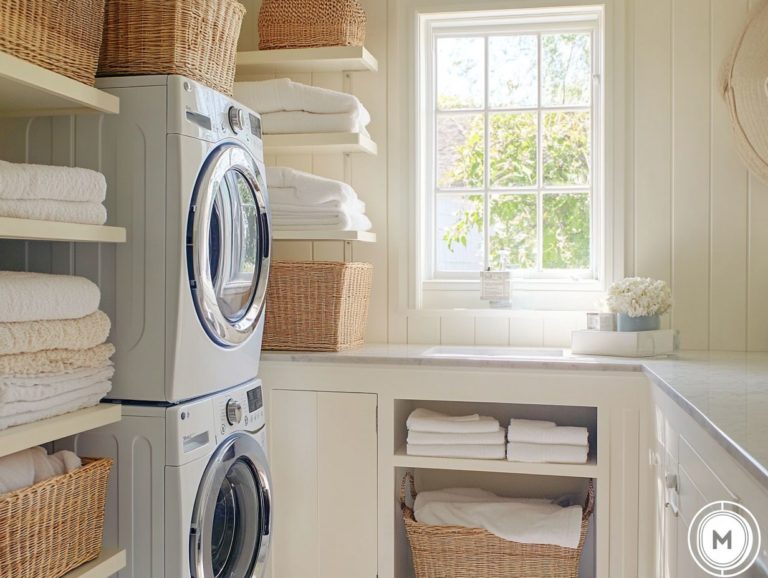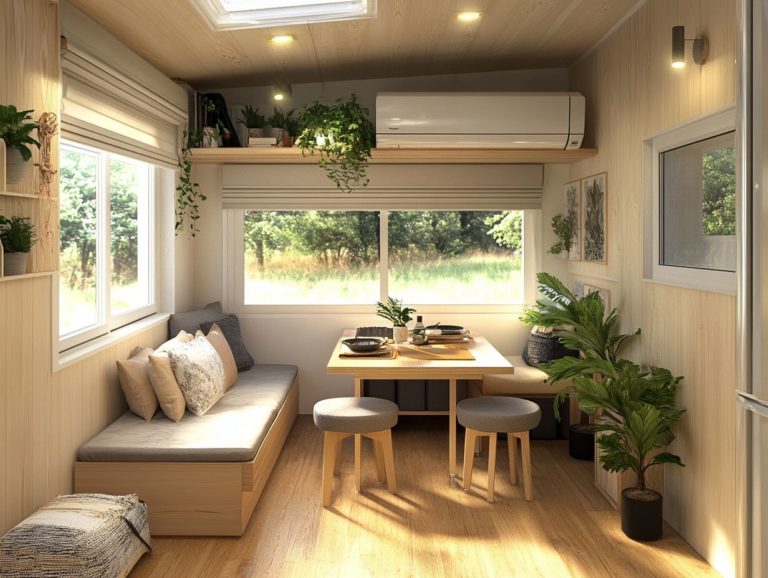Design Strategies for Tiny House Living Spaces
Are you intrigued by the tiny house movement captivating the globe? This article covers everything you need to know about tiny living.
Discover the benefits, including financial freedom, environmental impact, and lifestyle changes. We’ll also explore practical design strategies to make small spaces feel expansive.
Learn how to optimize layouts and create smart storage solutions. Harness natural light to make your space feel larger!
Dive in and discover the magic of living small!
Contents [hide]
- Key Takeaways:
- Benefits of Tiny House Living
- Designing for Small Spaces
- Layout and Floor Plan Considerations
- Storage Solutions for Tiny Houses
- Incorporating Natural Light and Greenery
- Utilizing Multi-Functional Furniture
- Innovative Design Ideas for Tiny Houses
- Frequently Asked Questions
- What are some common design strategies for tiny house living spaces?
- How can I make the most of vertical space in a tiny house?
- What are some key considerations when designing a tiny house living space?
- How can I create a sense of openness in a small living space?
- What are some budget-friendly design strategies for tiny house living spaces?
- How important is organization in a tiny house living space?
Key Takeaways:
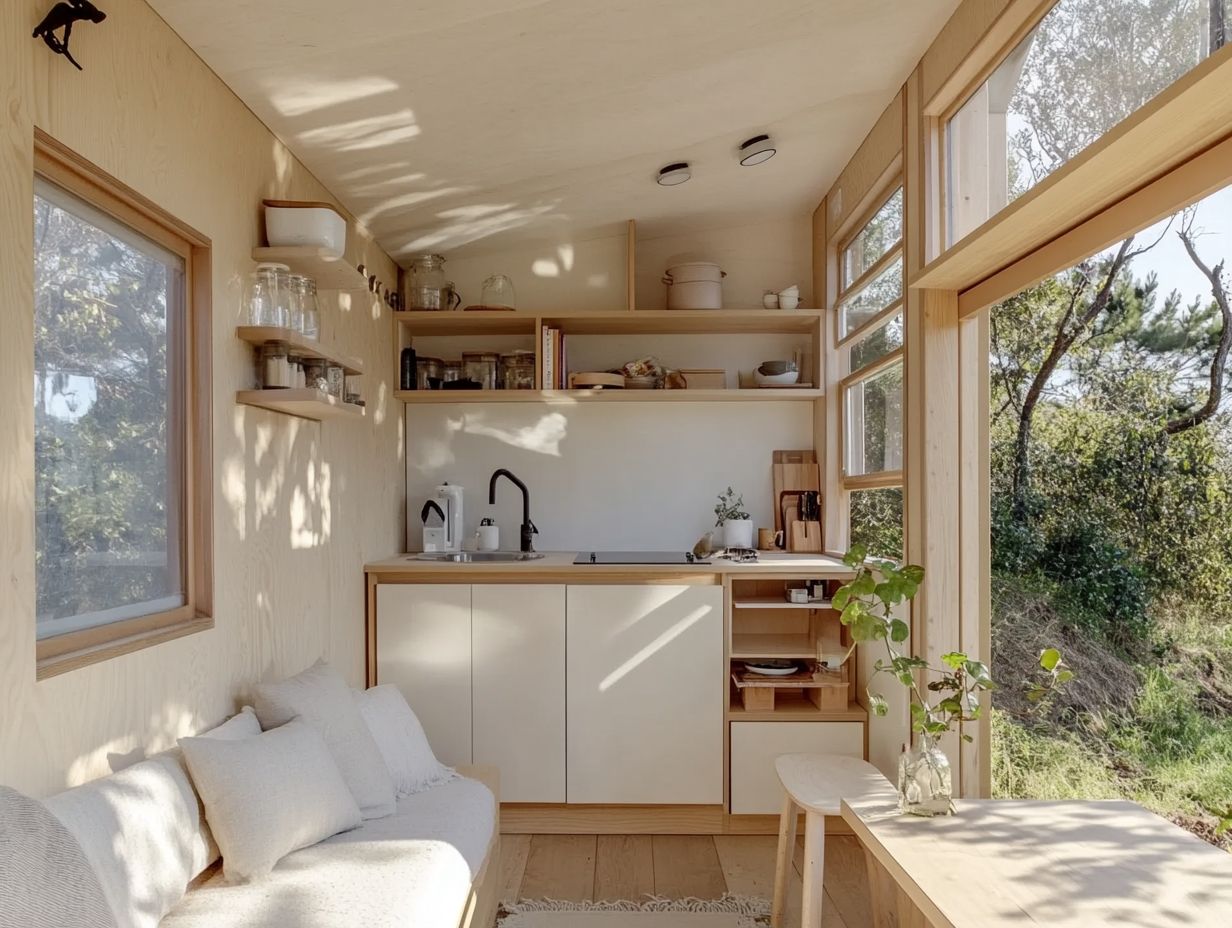
- Embrace the financial, environmental, and lifestyle benefits of tiny house living.
- Efficiently design small spaces with layout considerations, creative storage solutions, natural light and greenery, and multi-functional furniture.
- Think outside the box and incorporate innovative design ideas to make the most of your tiny house living experience.
What is a Tiny House?
A tiny house is a compact living marvel, typically ranging from 100 to 400 square feet, expertly designed to maximize making the best use of limited space while championing a minimalist lifestyle.
These dwellings often utilize eco-friendly materials and innovative techniques, reflecting the burgeoning trend of micro living.
With an emphasis on sustainable design and distinctive architecture, tiny houses attract individuals like you who seek a simple lifestyle that values functionality and environmental consciousness.
The tiny home movement beckons you toward community living. This lifestyle fosters shared resources and a sense of belonging, highlighting the significance of connection in our fast-paced world.
By embracing downsizing, many discover liberation from clutter and financial strain. This allows them to invest in experiences rather than mere possessions.
The diverse styles of tiny houses from sleek modern designs to charming rustic cottages offer personal touches that celebrate your creativity while adhering to energy-efficient principles. This lifestyle not only diminishes your carbon footprint but also cultivates a deeper appreciation for nature and the simple joys of everyday living.
Benefits of Tiny House Living
Start your journey with tiny house living and unlock incredible benefits today! Enjoy financial savings, environmental stewardship, and lifestyle enhancements.
By opting for a smaller footprint, you can significantly cut down on housing expenses, lessen your ecological impact, and adopt a minimalist lifestyle that promotes well-being and encourages personal growth.
This approach resonates deeply with those who aspire to live simply and sustainably, creating a fulfilling life that aligns with your values.
Financial, Environmental, and Lifestyle Advantages
The financial benefits of living in a tiny house are hard to ignore. You ll enjoy lower mortgage payments, reduced utility bills, and minimal maintenance costs. This is an enticing choice if you re looking to downsize and embrace a sustainable lifestyle.
By opting for eco-friendly materials and efficient designs, you not only save money but also play a part in promoting environmental sustainability. The smaller footprint of tiny homes significantly cuts down on energy consumption, encouraging a lifestyle that truly values conservation.
Many tiny house inhabitants discover the joy of community living, where shared resources and communal spaces foster a profound sense of belonging. This way of life encourages simplicity, prioritizing experiences over possessions, and often leads to a more fulfilling existence.
Embracing tiny house living helps you cultivate a balanced life that aligns beautifully with your personal values and commitment to environmental stewardship.
Designing for Small Spaces
Designing for small spaces demands your creativity and ingenuity. It emphasizes the importance of maximizing every square inch through innovative solutions like multi-functional furniture and effective space management strategies.
Your goal is to craft a functional layout that not only meets the needs of the inhabitants but also maintains a captivating aesthetic appeal.
Maximizing Space and Functionality
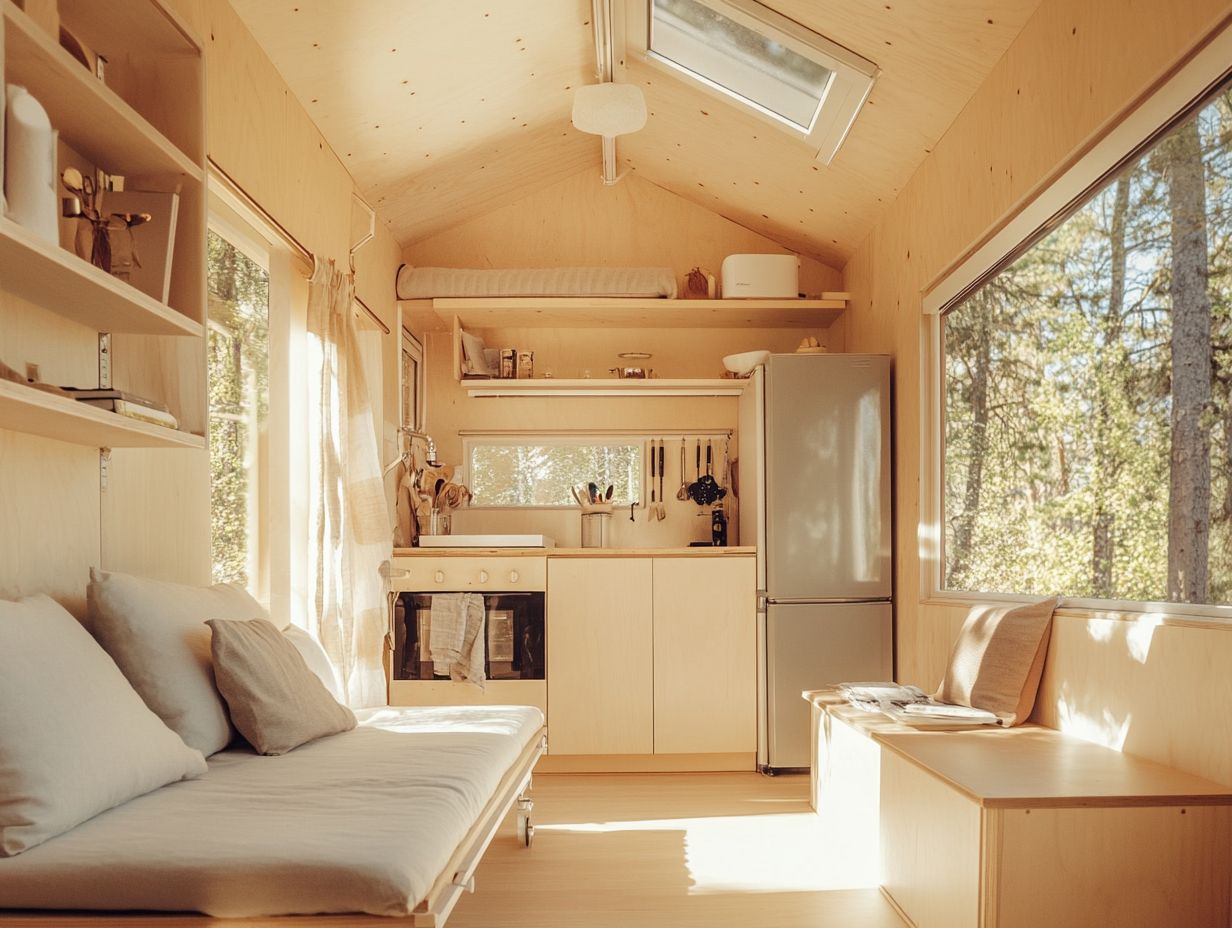
Maximizing space and functionality in a tiny house is crucial for crafting a comfortable and efficient living environment that perfectly suits your compact lifestyle.
Explore exciting techniques that can make a big difference, such as strategically using wall storage and incorporating loft beds. These can free up valuable floor space for your daily activities.
Creative storage solutions, like multipurpose furniture and hidden compartments, can significantly elevate your organization game.
Integrating design elements like ambient lighting and light color palettes creates an illusion of spaciousness, making your home feel larger and more inviting.
By focusing on both functionality and aesthetic appeal, you can transform your living experience into a harmonious retreat that truly reflects your personal style.
Layout and Floor Plan Considerations
When designing a tiny house, it s essential to thoughtfully consider the layout and floor plan. This careful planning is key to crafting a functional space that meets your needs and maximizes efficiency in every square foot.
Optimizing Layout for Different Needs
Optimizing the layout of a tiny house demands a keen understanding of your unique needs, ensuring that every small space is tailored to enhance both space efficiency and functionality.
For you, a kitchen that serves multiple purposes can be a delightful cooking space and a cozy gathering area while utilizing reclaimed materials for a warm yet modern aesthetic.
If you have a family, imagine having dedicated home office areas that offer a tranquil retreat for work or homework, complete with smart storage solutions like wall-mounted shelves to keep everything neatly organized.
Incorporating bamboo flooring not only adds a sustainable touch but also elevates the visual appeal of your tiny abode. By thoughtfully integrating these design elements, you can achieve a harmonious blend of style and practicality, making the most of every precious square foot.
Storage Solutions for Tiny Houses
Storage solutions are essential in tiny houses, demanding innovative and creative strategies to organize your space effectively.
By maximizing every inch available, you can maintain a clutter-free environment that enhances both functionality and aesthetics.
Creative and Efficient Storage Ideas
Creative and efficient storage ideas are crucial for keeping your small home organized, allowing you to make the most of every square inch without sacrificing style or comfort.
- Consider exploring innovative solutions like under-bed storage; that often-overlooked space beneath your mattress can become a sanctuary for seasonal clothing or seldom-used items.
- Fold-down furniture, such as wall-mounted desks and collapsible dining tables, offers the flexibility you need while conserving precious floor area, making your living space feel more open and inviting.
- Opt for furniture that doubles as storage think ottomans with hidden compartments or coffee tables with shelves for a seamless blend of functionality and aesthetic appeal.
- Embrace eco-friendly materials in your designs to contribute to sustainability while elevating the overall visual charm of your home.
Incorporating Natural Light and Greenery
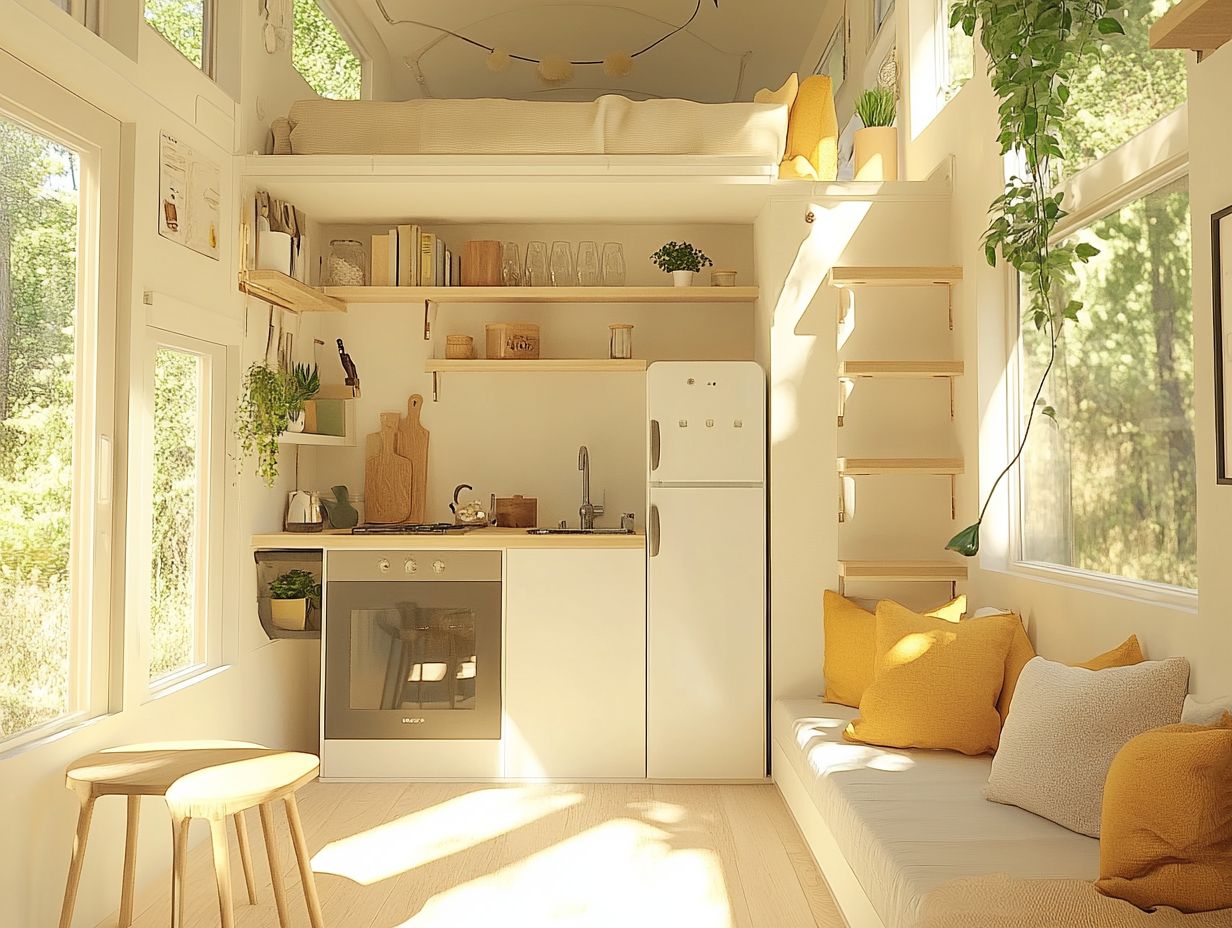
Incorporating natural light and greenery into your tiny house design elevates the entire ambiance, crafting a bright and inviting atmosphere that fosters both well-being and comfort.
This thoughtful integration transforms your space into a peaceful getaway, encouraging a harmonious connection with the environment.
Start transforming your tiny house today and enjoy a more spacious, functional living environment!
Designing for Natural Light and Indoor Plants
Designing a tiny house with a focus on natural light and indoor plants can truly transform the atmosphere. This approach promotes a healthier living environment.
Incorporating reflective surfaces like mirrors and choosing light-colored walls amplifies available light. This creates the illusion of a more spacious and inviting area. The strategic placement of windows is essential; positioning them to capture maximum sunlight brightens the space during the day and fosters a seamless connection with the outdoors. For those living in compact spaces, exploring innovative storage solutions for tiny houses can further enhance organization and functionality.
Integrating indoor plants elevates the ambiance, adding vibrant life and color while improving air quality. Opting for eco-friendly materials in your design process showcases your commitment to sustainability and enhances overall aesthetics. This approach helps create a serene, well-lit sanctuary that you ll love to call home.
Utilizing Multi-Functional Furniture
Embracing multi-functional furniture is essential in tiny house design. These pieces provide elegant space-saving solutions that enhance functionality while maintaining comfort and style.
Furniture that Serves Multiple Purposes
Furniture serving multiple purposes maximizes space in your tiny house. This allows you to enjoy both functionality and aesthetics in your living environment.
This innovative approach ensures that even the coziest spaces feel open and welcome, transforming corners into clever storage solutions. For example, consider a coffee table that doubles as a storage chest. It helps keep your living area clutter-free while showcasing unique architecture when not in use. To get more ideas, check out these top 10 tiny house interior design hacks.
A sofa bed is another game-changer, providing comfortable seating by day and transforming into a cozy sleeping area at night. This perfectly embodies the versatility needed in compact living.
Incorporating creative storage solutions like under-bed drawers or foldable desks significantly enhances both usability and visual appeal. This makes your small spaces feel much larger and more inviting.
Innovative Design Ideas for Tiny Houses
Innovative design ideas for tiny houses embody creativity and adaptability in modern living. They showcase unique architecture and sustainable materials, redefining what it means to call a place “home.”
Unique and Creative Design Concepts
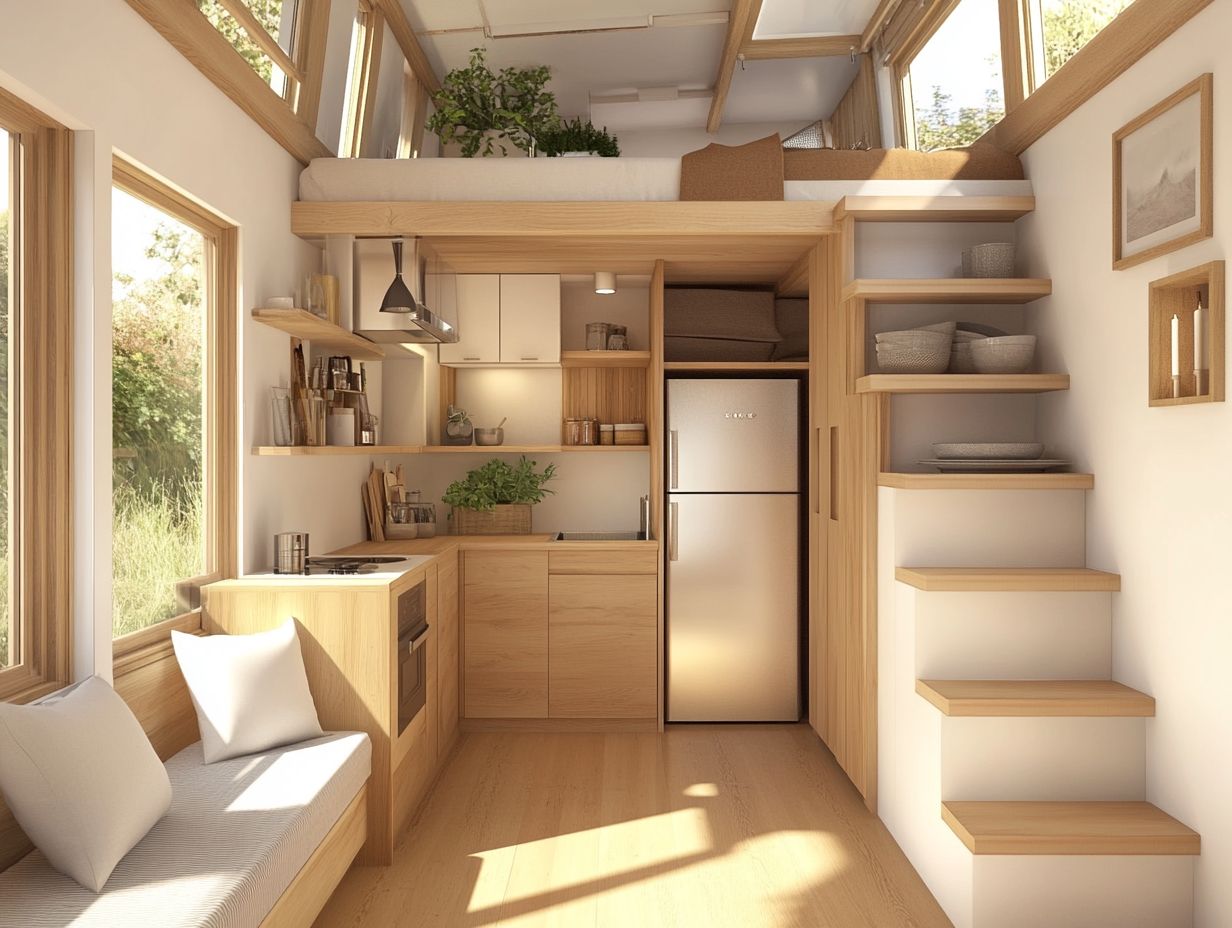
Unique and creative design concepts for tiny houses offer a fresh perspective on living spaces. They highlight modern design principles and innovative approaches to maximizing space utilization.
These designs often feature sleek lines and open floor plans that maximize every square foot. This allows you to enjoy both comfort and style in your cozy abode. Additionally, maximizing natural light in tiny house designs enhances the overall ambiance. Energy-efficient materials play a vital role, enabling sustainable living that cuts down on utility costs and minimizes your environmental footprint.
The clever integration of multifunctional furniture, such as foldable tables and wall beds, enhances visual appeal while ensuring a practical layout. Tiny house dwellers embrace architectural trends that invite natural light through expansive windows, fostering a seamless connection between indoor and outdoor spaces.
This ultimately redefines what it means to call a place home.
Frequently Asked Questions
Here are some common questions about tiny house living:
- What are the benefits of living in a tiny house? Living in a tiny house promotes minimalism, reduces expenses, and encourages a simpler lifestyle.
- How do I choose the right location for my tiny house? Consider factors like zoning laws, proximity to amenities, and access to nature.
- Can I have a garden in a tiny house? Yes! Many tiny houses incorporate vertical gardens or small outdoor spaces for gardening.
What are some common design strategies for tiny house living spaces?
Common design strategies for tiny houses include maximizing vertical space, using multi-functional furniture, and letting in natural light. Embracing a minimalist lifestyle is key for a clutter-free environment.
How can I make the most of vertical space in a tiny house?
Use height wisely! Wall-mounted shelves and loft spaces for storage or sleeping areas can help you make the most of your tiny space.
What are some key considerations when designing a tiny house living space?
Focus on maximizing functionality and optimizing your limited square footage. Incorporate your personal preferences to make the space uniquely yours.
How can I create a sense of openness in a small living space?
Light colors for walls and furniture can brighten up the area. Large windows and mirrors also help reflect light and create an airy feel.
What are some budget-friendly design strategies for tiny house living spaces?
Get creative with repurposed or secondhand furniture. DIY solutions can also make a big difference in maximizing your small space.
How important is organization in a tiny house living space?
Organization is crucial! It helps you maximize your space and keeps everything clutter-free. Use baskets, bins, and shelves to keep your belongings tidy and out of sight.

